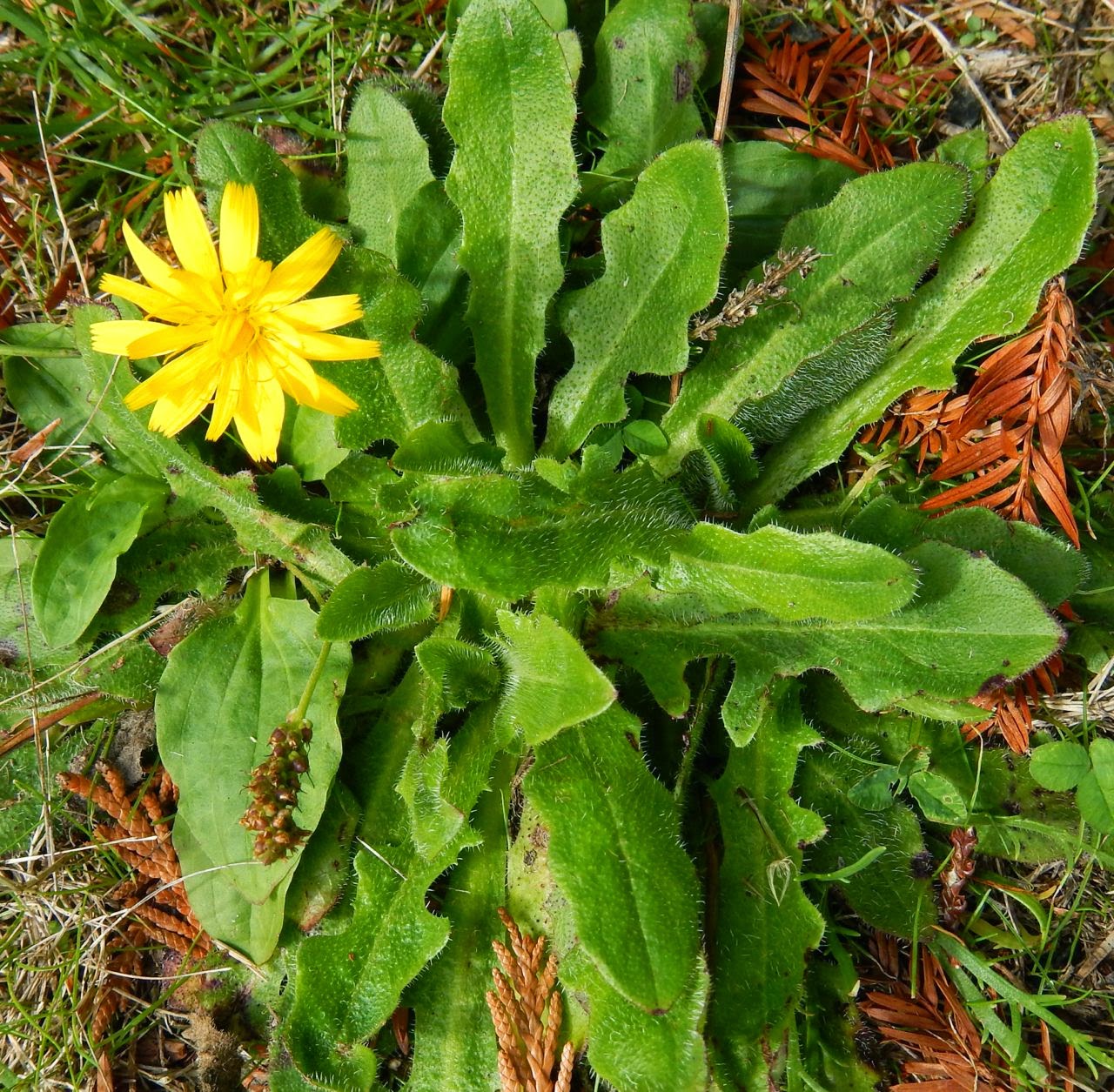Slugs and snails are mollusks, one with a shell, one without, that moved to land from water millions of years ago. It’s been a successful shift for them. Mollusks are one of the most prolific and diverse animal phyla on earth; the air-breathing species are both abundant and widespread. These species no longer need to live in water for any stage of their life cycle. In our temperate and humid climate, several species are very much at home in gardens.
 |
| Dandelion leaves are smooth, thin and sharply lobed, and grow in low rosettes with one flower per stem. It flowers in spring and again in fall. |
 |
| Rosettes of hairy cat's-ear are thick, dotted with hairs and roundly lobed; plants grow in thick rosettes with several flowers per stem. It flowers from summer into fall. |
Hatchlings eat their way out their eggs, then the tiny mollusks begin a life of eating and growing. Native slugs and snails eat fungi, decaying wood, and mosses in the woods. Introduced species prefer garden plants and do not normally enter natural woodlands.
Natural pests include many birds, especially when the mollusks are very small. Chickens will eat both eggs and young. Ducks and garter snakes prefer the larger animals. In fact, garter snakes are excellent slug predators. A nice warm compost pile, a few smooth warm rocks to bask on, a source of freshwater in the garden, and you have all the amenities of life that a garter snake prefers, along with fresh slugs and snails for them to eat.
 |
| A young slug on a cat's-ear leaf hatched just a few days ago. All of the mollusks that use leaf rosettes in lawns for egg cover and food are introduced species; most are from Europe. |
Like deer, European slugs and snails have cosmopolitan tastes––they will browse anything new at least once while deciding if it’s edible or not. One year I planted a native orchid, carefully enclosed it in a ring of slug bait, went back to the house for the durable tag––and when I came back out a few minutes later, a spotted leopard slug and a brown snail were circling the bait ring, enticed by the new plant. The next year, they left it alone.
If you aren’t comfortable cutting, crushing or salting these animals, is tossing effective? How far must you toss a snail or slug to keep it from coming back? Several scientists in England who are also gardeners studied this in their own gardens and neighborhoods.
One man used dots of white paint on snail shells, and tossed them out of his garden, over two fences onto open land, adding a dot every time a previously marked snail showed up. The record holder was a snail that returned 17 times. The average time to return was a month. The next year, he worked with a statistician, numbered the snails and either tossed them (even numbers) or moved them about 70 feet (20 meters) to another garden (odd numbers). Only 3 of 151 odd-numbered snails returned.
Another gardener tested snail homing abilities by painting numbers on her snails, persuading her neighbors to do the same, all using different colors, one color for each garden, then swapped them around in the neighborhood. She found that snails can often find the way back, over a distance of about 32 feet (10 meters).
An ecologist working with her was intrigued by this finding. He attached LEDs to some snails, and painted others with glow-in-the-dark paints. Using time-lapse photography, he found that snails move about 1 meter (3.2 ft) a hour at top speed, and could move up to 10 meters (32 ft) per night. “In wet weather, they form convoys, sliding along the slime trails of preceding snails, which Hodgson suspects helps them save energy.” (New Scientist, 12 July 2014, page 37) To see a time-lapse video of LED-marked snails, go to http://www.thisiscolossal.com/2013/08/timelapse-video-of-hundreds-of-snails-tagged-with-leds-at-night/
If snails keep returning, is tossing useful? Yes, because it may help give plants a break in being eaten. They grow stronger with a few days of rest from munching, and when the snails return, plants are better able to cope with the damage. The farther away the snails are taken, the fewer return; 20 meters (70 ft) is good as a tossing/moving distance, but even 5 meters (16 ft) gives plants a few days break.
Both slugs and snails can be seen determinedly gliding somewhere, heading for their preferred foods in my garden when weather is cloudy and moist. This is a good time to practice slug and snail tossing. Just don't toss them into your neighbor's garden!

